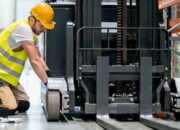Use energy-saving electric forklifts.
Conventional electric forklifts are built with small and medium lifting capacities, to be able to move flexibly and meet the requirements of handling different situations. An economical technology for power consumption.
Electric forklifts often operate for a long time, controlling the amount of power consumption can greatly reduce the cost of work. Electric forklifts of the same type have the same working conditions, different operating speeds, and different power consumption. Therefore power consumption will be lowest only when running at a certain speed. To save energy, electric forklifts should be driven in direct gear or high gear at medium speed, so the effect will be more obvious.

In addition, the power consumption of the equipment in an electric forklift is related to its engine temperature. If the temperature is too high or too low, the power consumption will increase, so maintaining the engine temperature is one of the main methods to save power consumption. Engine heating when used in low temperature conditions, if preheating is done, the power saving of electric forklifts is also very helpful.
Battery forklift is a forklift that uses a battery as power source to drive the relay motor and hydraulic system motor, and then completes the delivery and loading work. It has high durability, reliability and wide applicability used in many industries. There are mundane applications. So in the process of using a forklift we can easily ignore what problems, the following people are easy to get used to.
When using electric forklifts to load goods, it is necessary to carefully manage the load center, in the comments, the load center distance is the center of gravity of the electric forklift when the forklift is lifting goods. Usually refers to the center of the length of the cargo. Assuming the forklift’s fork length is 1.20 meters, the load center is 600mm. If your row is 3 meters long and the center of the row is 1.5m, it is definitely not possible to use a 1.20 meter forklift. Even if there will be an answer in the near future, it is very likely that dumping will occur, which is an extreme crisis.
When the forklift is moving forward, if the fork is raised too high, the height of the forklift’s overall center of gravity will increase, and the stability of the forklift will be affected. Therefore, when moving forward, the fork should not be raised too high, the height of the lower end above the ground should be kept at 300-400mm, the load should be in the lowest position without hindering the advance, the rig should be tilted. rearward and it should not be raised unless stowed or loaded. When going in and out of the assignment site or on the go, be careful if there are any obstacles in the sky. If you need to carry a large object, it will block the driver’s view, so turn the forklift upside down.
When the electric forklift is turning, if there are pedestrians or vehicles nearby, it is necessary to notify and take precautions to make sharp turns at high speed, otherwise the vehicle will lose stability and overturn. Stop flames and skids on downhill, under non-exclusive conditions, stopping the forklift brake when the forklift is moving forward. Do not brake unless the load is transitioning more than 7 degrees and when going up and downhill at a higher speed than the first gear. After unloading, the fork must be lowered to the normal forward address before forwarding.
When electric forklifts operate in the workshop area, they must also obey traffic laws, need to keep a certain safe distance from the vehicle in front. Because it is driven by the rear wheel, it is necessary to be careful with the rear swing to avoid the sudden rollover that often occurs when you first start driving. Block when turning on the road and cannot advance over the ramp. When the forklift loads downhill, back up, otherwise the load may tip over.







